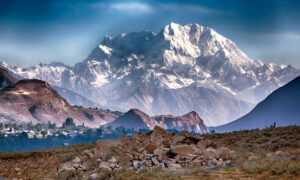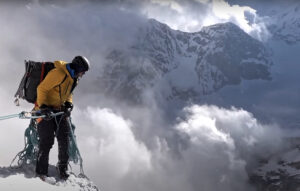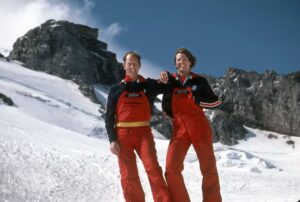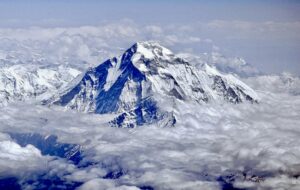Simon Gietl and Roger Schaeli have set out to climb the six great north faces of the Alps, a classic achievement for expert alpinists. Their unique wrinkle: They intend to travel only by human power between the mountains, trekking, cycling and paragliding.

Cheese for the road? Friends cheered Simon Gietl and Roger Schaeli at the first cycling leg of their trip. Photo: Simon Gietl
Skis might come in handy soon. Forecasts look good for the next three days, but autumn snow might come as early as next week.
The alpinists estimate that they will climb a total of 30,770 vertical meters, descend 29,470m, and cycle about 1,000km.

Climbing Cima Grande di Lavaredo in the Dolomites. Photo: Simon Gietl
Two down
Their quest began on September 14 when Gietl and Schaeli climbed 2,999m Cima Grande di Lavaredo in the Dolomites. They then cycled 334km to Piz Badile (3,308m). The following day, they completed the Cassin route on the mountain in three hours. From the summit, they paraglided down to Bondo.

Schaeli (left) and Gietl on top of the Cima Grande di Lavaredo
Two down, four to go. But the hardest climbs now begin. Next, they go to Grindelwald for the Eiger Nordwand (3,967m). They then go to Zermatt for the Matterhorn (4,478m). Finally, they pedal to Chamonix for a grand finale on the Grand Jorasses (4,208m) and Petit Dru (3,733m), the legendary spires rising from the Mont Blanc massif.

The climbers glide down from Piz Badile to the town of Bondo. Photo: Roger Schaeli
Rebuffat and Destivelle
Attempting the great six north faces of the Alps has lured climbers since the 1930s. Gaston Rebuffat was the first to bag them all in 1954. Climbers from around the world have tried to follow in his footprints, doing it at various speeds, styles, and via different routes. In the 1990s, Catherine Destivelle became the first woman to do all six. Tom Ballard climbed them in winter, solo and unsupported, in 2014-15.
The current project by Schaeli and Gietl focuses less on records than on simple, human-powered transport. The climbers do have a support team, however.

Fast climbing on Piz Badile’s summit ridge. Photo: Roger Schaeli
In the current times of environmental sensibility and climate crisis awareness, the quest looks fashionable. And yet, not so long ago, being green wasn’t an option — it was the only option.
In his autobiography Summits and Secrets, Kurt Dienberger recalls how he and his friends, poor post-war Austrian teenagers, dreamed of climbing a mythical mountain “far, far away, somewhere over the horizon in an unknown land…The Matterhorn!… We had never been to the Western Alps. We had no money, but we had our dreams…At least, those we could get to on our bicycles.”
It took them a week to pedal from their Austrian village to Zermatt.






